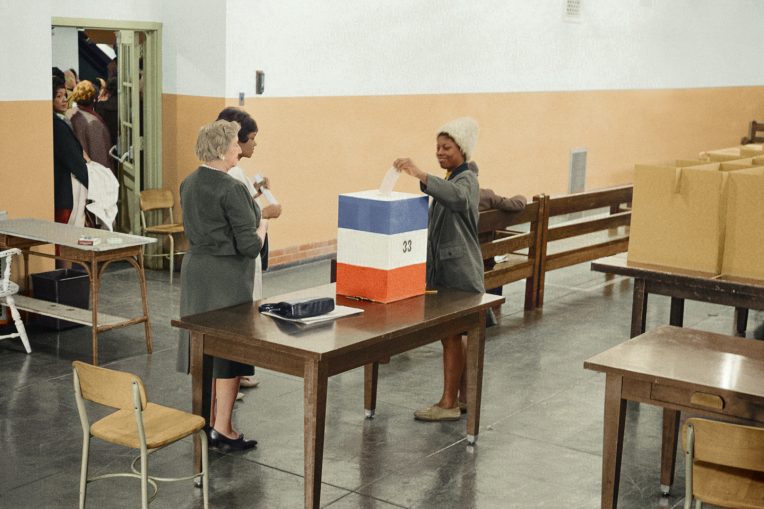Last fall, the Voter Engagement Coalition launched the Voter Restoration Initiative to increase awareness of voter suppression in marginalized communities through a series of resources to spark conversation.
Historically, the term “voter restoration” has been associated with returning voting rights to individuals with felony convictions. The Voter Engagement Coalition extended the term to broaden the conversation.
“These are important topics and critical conversations we should be having year-round, not just during a national election,” said Harriett Steinbach, assistant director at the Center for Civic Engagement (CCE) and co-chair of the Voter Engagement Coalition. “Voting rights for individuals are still suppressed in many areas, and without a larger, ongoing conversation, we cannot hope to address the systemic problems involved.”
According to Steinbach, the original idea for the initiative came from Tashay Dennie, assistant dean for Leadership Education and Development in the Dean of Students Office. “She was on the Voter Engagement Coalition and suggested the idea,” said Steinbach. “I absolutely loved it because it hits on the social justice issues present in voting. Voting is a right, but it is important for everyone to understand the historic fights for various peoples to access that right. Folks are still fighting for that right.”
For Dennie, the idea for the initiative was born from both personal and professional experiences, including her daily work with students. “The idea of Voter Restoration really came from my effort to center the margin in the conversation of voting and to extend the concept to voter restoration to include not only our disenfranchised students, but students who are discouraged and disabled from participating in the democratic voting process.”
Dennie noted that some students she works with do not vote because of their awareness of suppression. “I learned very quickly that for many of them, their choice to not vote wasn’t because of what they didn’t know, their choice to not vote was because of what they do know as a result of their lived experiences and the lived experiences of their family and community members in regards to voter suppression.”
Her idea for the initiative, then, was to create and cultivate spaces of healing and justice for democracy through community storytelling, dialogue, and advocacy. “Centering my own experiences and the experiences of my elderly-family members,” said Dennie. “I personally find it challenging to have conversations about voter registration and voter education, because there is rarely space to center the lived experience of marginalized communities of color who have historically and are still today affected by injustice and oppressive systems of power within the democratic voting process.”
Dennie and Steinbach both credit CCE graduate student Katelyn Hill with compiling many of the topics and resources offered through the initiative. The initial focus was on groups of people from marginalized backgrounds who have spoken out for their rights and made important contributions to democracy, though their voices are often left out of history textbooks.
According to Hill, a look at the history of voting rights in the United States directed her efforts, as well as contemporary concerns about how the global pandemic may affect access to voting. “There are many groups that have historically been excluded from political engagement,” said Hill. “I wanted to highlight the history of how they have fought to have their voices heard, as well as the current efforts regarding voter restoration.”
Resources were posted online in September, October, and November 2020, with a new topic being addressed each week. Reflection questions were also included. The topics covered were:
- COVID Concerns the Mail-In Vote
- The Power of the Youth Vote
- Tribal Communities Fighting to Vote
- The Latinx Voting Movement
- Voter Restoration and the War on Drugs
- Black America and the Evolution of Voter Suppression
- The 19th Amendment and Women of Color
- The Century-Long Fight: The Black Sorority Movement for Voting Rights
“A goal for this initiative was for students to absorb and be engaged in the material,” said Hill. “We figured the best way to achieve this would be to find videos that covered the topics, such as documentaries, new clips, interviews, YouTube. Some topics were not covered in videos, so I included relevant articles and websites. Also, some professors shared a few resources that we included in the Initiative.”
The Voter Restoration Initiative topics and resources are all still available within the Redbird Voter Guide. The Voter Engagement Coalition plans to build on the content in the future.
“What we did this past year is just the beginning,” said Steinbach. “It was what we were able to do with just a little bit of time. We hope to build from this foundation, adding and updating resources. We would also like to incorporate community conversations where faculty and students participate in recorded discussions on the various topics. We hope this content can serve as an important resource for faculty to utilize in the classroom.”
Dennie hopes that the resources offered to date, as well as those added in the future, will lead students to step into their power and leadership for social change. “For those familiar to the topics presented, by way of personal experience and/or historical connection from communities of origin, I hope the Voter Restoration Initiative brings a sense of acknowledgement, testimonial justice, hope, healing, and forward movement toward equity.”
“For those not as familiar with the topics presented,” she continued. “I hope the Voter Restoration Initiative presents an opportunity to learn the histories of oppression and legacy of resilience within marginalized communities who have been historically silenced and suppressed in American democracy.”

